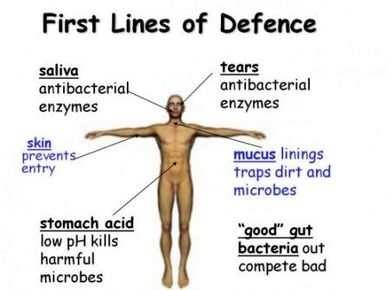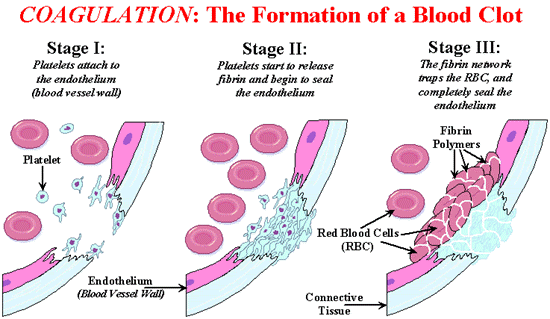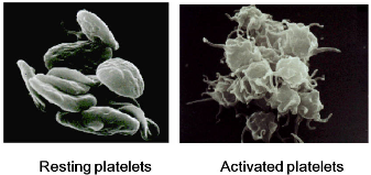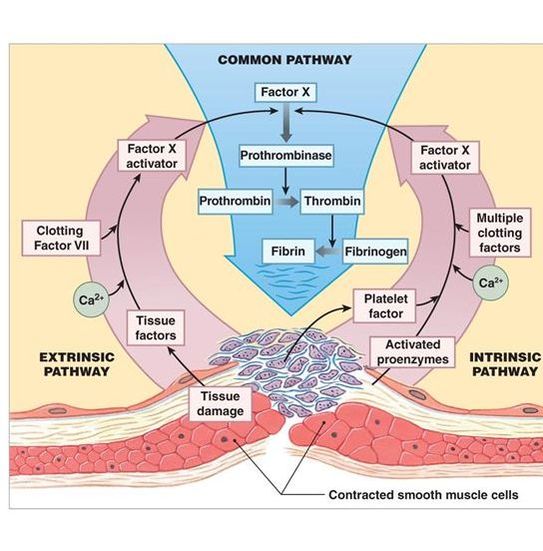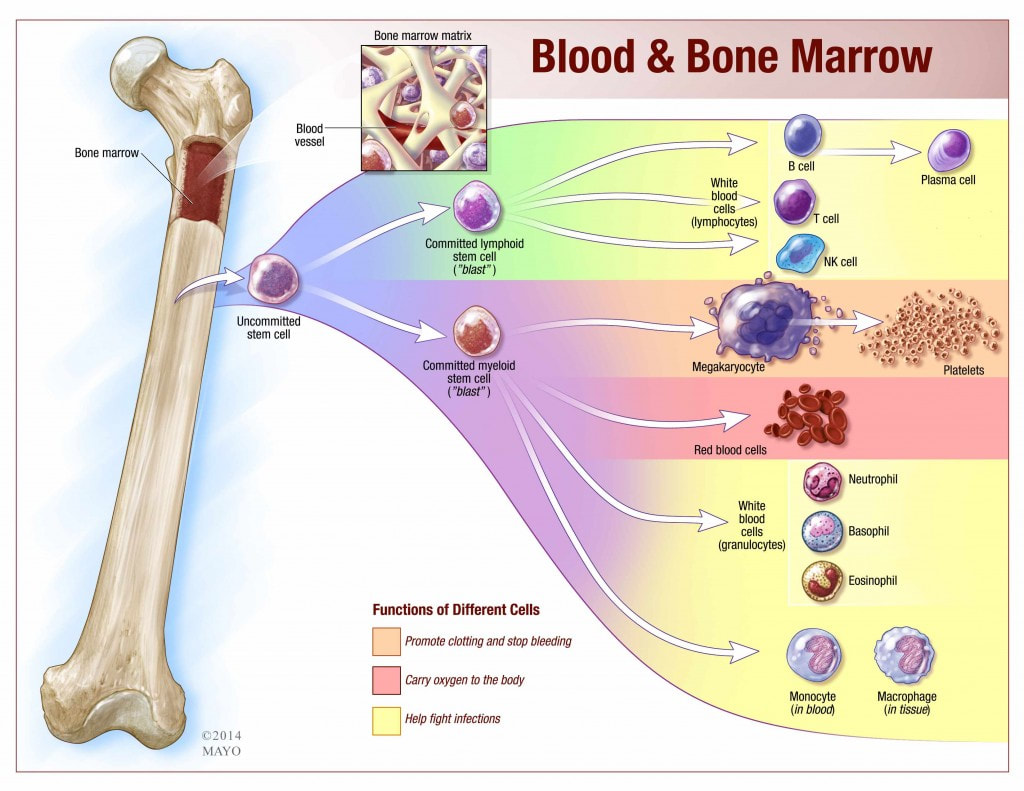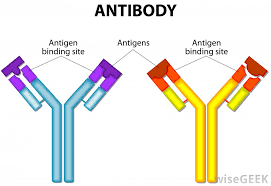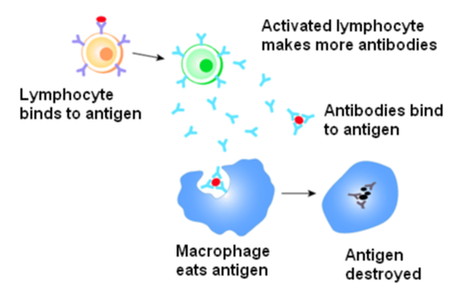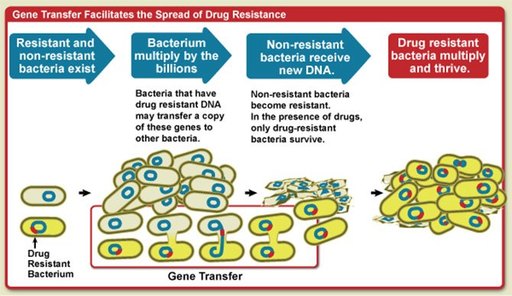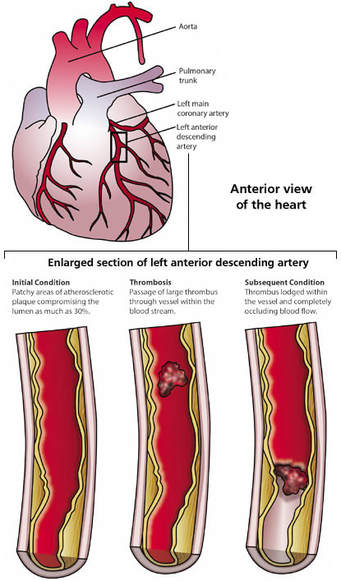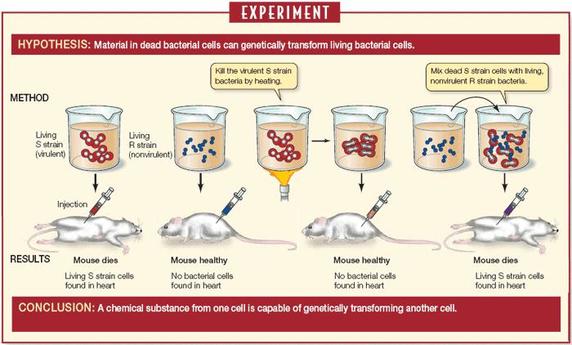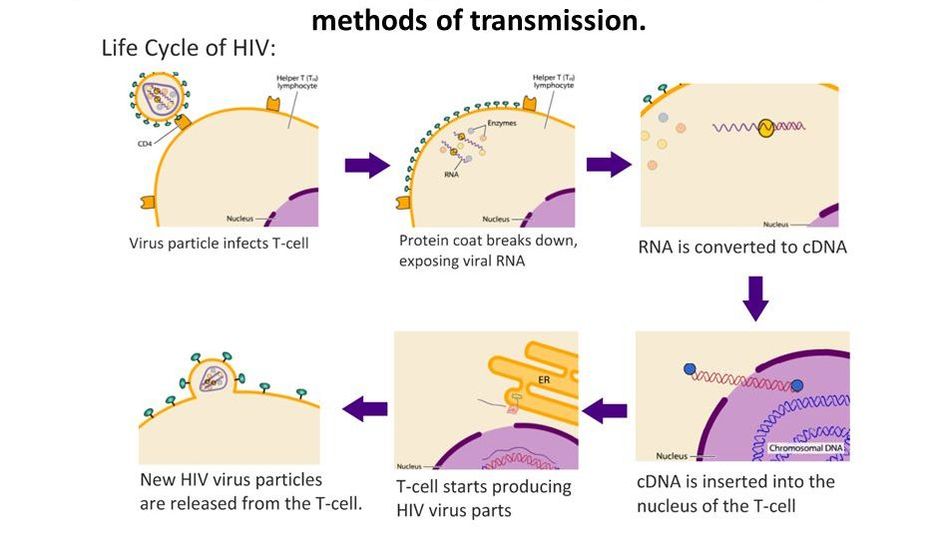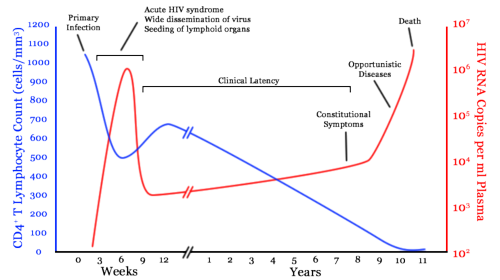topic 6.3: defense against infectious disease
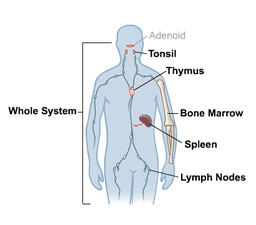 image from MedlinePlus
image from MedlinePlus
In the Defense Against Infectious Disease unit we will learn that pathogens and viruses invade the body and cause diseases. Most pathogens are bacteria and viruses, but protozoan, parasite worms and fungi can also be pathogenic. You will also learn the mechanisms in which the body defends itself against these pathogens.
This unit will last 3 school days
This unit will last 3 school days
Essential idea:
- The human body has structures and processes that resist the continuous threat of invasion by pathogens.
Nature of science:
- Risks associated with scientific research—Florey and Chain’s tests on the safety of penicillin would not be compliant with current protocol on testing. (4.8)
- Compare allowable research risks of the past with those of the present
- Compare allowable research risks of the past with those of the present
Understandings:
6.3.U1 The skin and mucous membranes form a primary defence against pathogens that cause infectious disease.
- Define pathogen.
- State that skin and mucous membranes form the first line of defense against pathogens.
- Outline the role of skin, sebaceous glands and mucous membranes in the defense against pathogens.
The first line of defence against infectious disease are the surface barriers that prevent the entry of pathogens into the body. These surface barriers include both the intact skin and mucous membranes
- Skin and mucous membranes are physical barriers against infection from pathogens.
- Skin is constantly replacing its outermost epidermal layer of skin. These dead cells provide effective protection against foreign pathogens.
- Skin also secretes a substance called sebum to lubricate the skin. The sebum also lowers the pH of the skin, which effectively helps inhibit bacterial growth.
- Mucous membranes line the surfaces of the nasal cavity, trachea, bronchi, and bronchioles (surfaces that are exposed to the outside environment).
- Mucous traps foreign particles and pathogens contained in the air before they reach the lungs.
- Mucous contains lysozymes (enzymes) that can damage and kill pathogens.
- Trapped pathogens can also be expelled through the mouth or nose, or swallowed and destroyed by the high acidity of the stomach.
- Skin and mucous membranes are examples of non-specific immunity.
6.3.U2 Cuts in the skin are sealed by blood clotting.
- State two benefits of blood clotting when skin is cut.
Clotting (haemostasis) is the mechanism by which broken blood vessels are repaired when damaged. Blood clotting repairs and seals the skin to prevent excessive blood loss. When a blood vessel is broken or cut, blood platelets collect at the site of the damaged blood vessel forming a platelet plug
The two key components of a blood clot are platelets and insoluble fibrin strands:
The two key components of a blood clot are platelets and insoluble fibrin strands:
- Platelets undergo a structural change when activated to form a sticky plug at the damaged region (primary haemostasis)
- Fibrin strands form an insoluble mesh of fibres that trap blood cells at the site of damage (secondary haemostasis)
6.3.U3 Clotting factors are released from platelets.
- Outline two roles of platelets in the blood clotting cascade.
The process by which blood clots are formed involves a complex set of reactions collectively called the coagulation cascade. This cascade is stimulated by clotting factors released from damaged cells (extrinsic pathway) and platelets (intrinsic pathway)
Extrinsic pathway
Intrinsic pathway
Both pathways lead to a common pathway
Extrinsic pathway
- Triggered by factors released by injured endothelial cells or peripheral tissues
Intrinsic pathway
- Triggered by factors released by platelets stuck to vessel walls
Both pathways lead to a common pathway
- Thrombin converts soluble fibrinogen subunits to an insoluble polymer, fibrin
6.3.U4 The cascade results in the rapid conversion of fibrinogen to fibrin by thrombin.
- Describe the blood clotting cascade, including the role of platelets, clotting factors, thrombin, fibrinogen and fibrin.
The Extrinsic pathway and Intrinsic pathway leads to a common pathway
- The clotting factors convert the clotting protein prothrombin to its active form thrombin (enzyme).
- The enzyme thrombin converts clotting protein fibrinogen (which is soluble) into the insoluble fibrous protein fibrin.
- Fibrin forms a mesh at the point of the broken vessel further trapping other platelets sealing up the damaged vessel and forming a stable clot.
- Once the damaged vessel has fully healed, the blood clot dissolves in the blood.
6.3.U5 Ingestion of pathogens by phagocytic white blood cells gives non-specific immunity to diseases.
- State the white blood cells are the second line of defence against pathogens.
- Outline the function of phagocytic white blood cells in defense against pathogens.
Another type of non-specific immunity (not antigen specific and response is immediate) occurs when phagocytic leucocytes ingest and destroy foreign pathogens. When pathogens managed to get by skin and mucous membranes a second line of defense is available to remove them, phagocytic leukocytes ingest any pathogens in the blood and body tissues.
- The main types of phagocytic leucocytes are called macrophages. When pathogens get past the physical barriers, macrophages will engulf foreign pathogens through endocytosis.
- Pathogens are recognized as non-self cells by the structure of their protein coat.
- Once the pathogen is engulfed, lysosomes within the macrophage contain hydrolytic enzymes that will digest and destroy the foreign pathogens.
- Macrophages are the large white blood cells in the diagram below. Basophils, neutrophils and eosinophils are also involved in the non-specific immune response
- It does not differentiate between different types of pathogens (non-specific)
- It responds to an infection the same way every time (non-adaptive)
6.3.U6 Production of antibodies by lymphocytes in response to particular pathogens gives specific immunity.
- Define “specific immune response.”
- Contrast antigen and antibody.
- Describe the structure and function of antibodies.
- State the function of plasma cells and memory cells.
The immune system must encounter a foreign substance, called an antigen, before it can produce the necessary response to effectively remove the pathogen. An antigen is any foreign molecule found on the surfaces of viruses, bacteria, cancer cells that elicits an immune response. The response by the immune system to the antigen is the production of antibodies. An antibody is a protein found in blood plasma that attaches to a particular antigen to help control its effects. These antibodies are specific to that antigen.
- When a pathogen enters the blood, the specific antigen on the surface of the membrane is identified as being foreign or non-self
- This stimulates a specific immune response in which antibodies are produced that are specific for that particular antigen
- B-lymphocytes are white blood cells that produce antibodies that bind to the antigen on the invading pathogen
- Each lymphocyte is able to produce one type of antibody; however, we have a vast diversity of lymphocytes that are able to respond to millions of foreign antigens
- Once an antigen has been encountered the B-lymphocytes are stimulated to divide to produce a large amounts of clones of themselves (clonal selection)
- The active B-lymphocytes that are produced are called plasma cells which will begin to produce antibodies.
- The plasma cells created, produce and release mass amounts of antibodies into the bloodstream.
- These antibodies surround and bind to the antigens on the foreign pathogens.
- Through a variety of different methods the pathogens are destroyed by the antibodies and other white blood cells.
6.3.U7 Antibiotics block processes that occur in prokaryotic cells but not in eukaryotic cells. (Oxford Biology Course Companion page 306).
- Define antibiotic.
- Outline the mechanisms by which antibiotics kill bacteria.
Antibiotics are effective against bacteria but not against viruses. Antibiotics block specific pathways found in bacteria. Viruses do not have their own metabolic pathways, therefore, in order to reproduce us to use the metabolic pathways of the cells they infect. Antibiotics are not effective against viruses that have infected human cells because the metabolic pathways are not affected by the antibiotics.
- bacteria have the necessary organelles/enzymes which are useful in many different metabolic pathways
- antibiotics can block specific metabolic pathways found in bacteria
- antibiotics can inhibit enzymes that are used in these pathways and essential to the survival of pathogens (i.e. penicillin inhibits an enzyme that is used in making cell walls)
- antibiotics are ineffective against viruses which reproduce using the host cells metabolic pathways
- antibiotics may harm helpful bacteria that are found in humans
6.3.U8 Viruses lack a metabolism and cannot therefore be treated with antibiotics. Some strains of bacteria have evolved with genes that confer resistance to antibiotics and some strains of bacteria have multiple resistance. (Oxford Biology Course Companion page 308).
- Explain why antibiotics are ineffective against viruses.
Since viruses lack their own metabolism, they have to use the chemical processes of a cell from a host that they infect
Antibiotic resistance is an avoidable problem, which can be done by:
- They are unable to reproduce on their own and cannot perform protein synthesis, transcription and other metabolic functions
- Antibiotics work by blocking these vital processes in bacteria, killing the bacteria, or stopping them from multiplying
- Since viruses do not perform their own metabolic reactions antibiotics such as penicillin and streptomycin, are ineffective in treating viral infections
- Therefore treating viruses with antibiotics is not only useless and ineffective, it can also create antibiotic resistance in bacterial strains eg. Methicillin-resistant Staphylococcus aureus
Antibiotic resistance is an avoidable problem, which can be done by:
- Doctors prescribing antibiotics for only serious cases
- Patients completing courses of antibiotics to eliminate infections completely
- Hospital staff keeping high standards of hygiene to prevent cross-infection
- Pharmaceutical companies not producing new antibiotics
Application:
6.3.A1 Causes and consequences of blood clot formation in coronary arteries.
- State the function of the coronary arteries.
- Define coronary thrombosis.
- List sources of arterial damage that increase the risk of coronary thrombosis.
- List factors that are correlated with an increased risk of coronary thrombosis and heart attack.
Coronary arteries are arteries that branch from the aorta and supply oxygen to the heart. Individuals that have coronary heart disease sometimes form blood clots in these arteries. Coronary thrombosis is the formation of a clot within the blood vessels that supply and sustain the heart tissue (coronary arteries)
Some Causes
- If the arteries are blocked, that part of the heart becomes deprived of oxygen and vital nutrients.
- The heart can no longer produce the amount of ATP (through aerobic respiration) needed for the heart to work properly
- The individual is therefore at a high risk of having a possible fatal heart attack
- Atherosclerosis is a disease of the arteries characterized by the deposition of plaques of fatty material on their inner walls.
- The arteries become damaged and coarsened and the wall of the arteries is hardened by calcium salts.
- This blocking of the arteries can lead to a heart attack
Some Causes
- Smoking
- Obesity and lack of exercise
- Hypertension (high blood pressure)
- Diabetes
6.3.A2 Florey and Chain’s experiments to test penicillin on bacterial infections in mice.
- Explain methods and results of Florey and Chain’s experiments.
- A bacteriologist named Alexander Fleming originally discovered Penicillin in 1928
- Later on, two scientists named Florey and Chain were able to develop a method of growing the Penicillin in liquid cultures and purifying the Penicillin in these cultures.
- They started by testing on mice infected with Streptococcus bacteria which would cause death in the mice if left untreated
- Four mice were given Penicillin shots and four were left untreated
- Within one day, all of the untreated mice were dead
- Human trials on five individuals commenced when enough of the penicillin was created. All of these people survived their initial infection; however, a small child died when an artery behind his eye burst
- After this, penicillin became widely produced and used by pharmaceutical companies
6.3.A3 Effects of HIV on the immune system and methods of transmission.
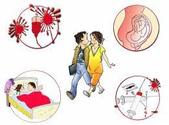
- HIV (human immunodeficiency virus) is a retrovirus that causes AIDS, which is a condition in humans where the immune system fails and is susceptible to life-threatening opportunistic infections.
- HIV targets helper-T cells because HIV can bind to the proteins on the T cells.
- Helper-T cells play an important role in the production of clonal B lymphocyte cells, which produce antibodies for immune response.
- Therefore the reduction of T cells will reduce the amount of antibodies produced needed to fight off infection from invading pathogens.
- This inability to fight off disease is what eventually causes the person to die.
Production of HIV particles damage T-cell production
Social Impacts
Economic impacts
- discrimination and stigma from those around
- abuse and harassment
- may not be able to find work
- may not be healthy enough to work
- expense of medications bankrupts families
- risk of spreading in a family or commuity
- burden of care for the sick
Economic impacts
- working-age population is reduced
- GDP suffers as a result
- more children have to work, so less are in school
- education of nation suffers
- heavy economic burden of medications and care
- international stigma and impacts on trade/industry
Key Terms:
|
pathogen
primary defence trachea lysozyme macrophage binding site helper-T cell clone cell challenge thrombrin plasma cell lymphocyte |
antibodies
secondary defence nasal passage phagocytic specific response B lymphocyte mutate epitope response antibiotic resistance coronary thrombosis |
antibiotics
eukaryotic urethra leucocyte non-specific response memory cell transfusion skin sebaceous glands platelets coronary arteries eukaryotic cell |
virus
bacteria vagina immunity protein HIV ELISA clonal selection blood clot specific immunity Florey and Chain prokaryotic cell |
mucus membrane
prokaryotic cilia phagocytosis antigen AIDS immune protozoa fibrinogen penicillin fibrin |
PowerPoint and Notes on Topic 6.3 by Chris Payne
PowerPoint and Notes on Topic 6.3 by Chris Payne
Your browser does not support viewing this document. Click here to download the document.
Your browser does not support viewing this document. Click here to download the document.
Correct use of terminology is a key skill in Biology. It is essential to use key terms correctly when communicating your understanding, particularly in assessments. Use the quizlet flashcards or other tools such as learn, scatter, space race, speller and test to help you master the vocabulary.
External Links:
Check out some more of the videos from the Walter and Eliza Hall Institute of Medical Research.
Try this animation and quiz: McGraw Hill Online Centre
Nobel-winner, the cellular response from CancerResearch.org
The humoral, though not funny, response – from the LifeWire
How does the leukocyte know where to go? Chemotaxis – from Wisc-online
Loads more links to clips at North Harris College.
The Immune System Game
HIV and AIDS Case Study
Newborn baby ‘cured’ of HIV with rapid detection and ARV treatment. Great introduction to the topic from the New York Times.
Could the design of a condom improve HIV prevention? Here is a South African company who hope so: Pronto Condoms.
For a video of how it works (on a plastic model), click here.
AIDS Fact Sheet from WHO
Antibiotics & Resistance
From Wired: “Superbugs found in New Delhi’s water and sewage,” which claims that antibiotic resistant genes (NDM-1 enzyme) have appeared in Vibrio cholerae.
In the News:
Bee Sting Allergy Could be a Defence System Gone Haywire from Science Daily
WebMD reports New Drug May Help Immune System Fight Cancer
Study reveals key role of the immune system in defending brain against Alzheimer’s from the Independent
Medical Press reports Geneticists map human resistance to HIV
Check out some more of the videos from the Walter and Eliza Hall Institute of Medical Research.
Try this animation and quiz: McGraw Hill Online Centre
Nobel-winner, the cellular response from CancerResearch.org
The humoral, though not funny, response – from the LifeWire
How does the leukocyte know where to go? Chemotaxis – from Wisc-online
Loads more links to clips at North Harris College.
The Immune System Game
HIV and AIDS Case Study
Newborn baby ‘cured’ of HIV with rapid detection and ARV treatment. Great introduction to the topic from the New York Times.
Could the design of a condom improve HIV prevention? Here is a South African company who hope so: Pronto Condoms.
For a video of how it works (on a plastic model), click here.
AIDS Fact Sheet from WHO
Antibiotics & Resistance
From Wired: “Superbugs found in New Delhi’s water and sewage,” which claims that antibiotic resistant genes (NDM-1 enzyme) have appeared in Vibrio cholerae.
In the News:
Bee Sting Allergy Could be a Defence System Gone Haywire from Science Daily
WebMD reports New Drug May Help Immune System Fight Cancer
Study reveals key role of the immune system in defending brain against Alzheimer’s from the Independent
Medical Press reports Geneticists map human resistance to HIV
International-mindedness:
- The spread and containment of diseases such as bird flu require international coordination and communication.
Video Clips
Every second of your life you are under attack. Bacteria, viruses, spores and more living stuff wants to enter your body and use its resources for itself. The immune system is a powerful army of cells that fights like a T-Rex on speed and sacrifices itself for your survival. Without it you would die in no time. This sounds simple but the reality is complex, beautiful and just awesome. An animation of the immune system.
The immune system is a vast network of cells, tissues, and organs that coordinate your body’s defenses against any threats to your health. Without it, you’d be exposed to billions of bacteria, viruses, and toxins that could make something as minor as a paper cut or a seasonal cold fatal. So how does it work? Emma Bryce takes you inside the body to find out
Do you remember having a cold in 5th grade? Or the flu a couple years ago? Your immune system does. Our bodies hold many levels of immune defense
HOPEHIV turns 10 in 2010 and this four minute video (low res MPG) shows just how far the charity has come: from one little girl in a Joburg orphanage to supporting 50,000 orphans and vulnerable young people in Africa each year
TED Talk by Bonnie Bassler on bacteria and how we interact with them:
Hank tells us about the team of deadly ninja assassins that is tasked with protecting our bodies from all the bad guys that want to kill us - also known as our immune system.
Paul Andersen explains how your body protects itself from invading viruses and bacteria. He starts by describing the nonspecific immune responses of skin and inflammation. He then explains how we use antibodies to disrupt the function of antigens and mark them for destruction. He then explains both the homoral and cell-mediated immune response highlighting the importance of B and T lymphocytes. He finally describes the process of long term immunity
This video gives a great overview of the cells and functions of the immune system in response to a pathogen. Both the innate and adaptive immune system are explored.
Here are some very clear clips for the immune responses to infection, starting with a really well done explanation of Burnet’s Nobel-winning clonal selection theory:
Neutrophil (phagocyte) chasing a bacterium:
Elizabeth Pisani discusses rational behaviour in HIV infection, with lots of Indonesia references:
Hans Rosling explodes the Africa=HIV myth using real stats:
90-day time-lapse of a woman on modern anti-AIDS medication:
So what could happen (and what has in the past) when there is a pandemic? This enlightening BBC Horizon documentary sheds a little light.
What are HIV & AIDS? HIV, or human immunodeficiency virus, is a type of virus that infects human immune cells. Over time, immune cells are lost, which weakens the immune system and allows patients to be infected by other viruses and develop several types of tumors
In the first video in our two part series on HIV and AIDS, we explain how scientists figured out what HIV is, when the infection morphs into AIDS, and where they think the virus originated
SciShow News reports some promising new findings about the worldwide fight against HIV, including insights about how we can make the most of one of our newest weapons against HIV: circumcision.
2008, something incredible happened: a man was cured of HIV. In over 70 million HIV cases, this was a first, and, so far, a last, and we don’t yet understand exactly how he was cured. But if we can cure people of various diseases, like malaria and hepatitis C, why can’t we cure HIV?
This video is about Forey and Chain and their part in the discovery of penicillin
